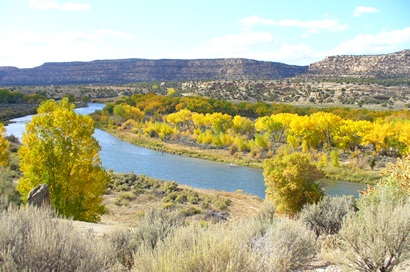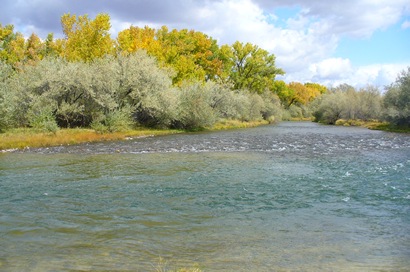| |
Fly-Fishing
in New Mexicoby
Byron Browne | |
Before
I left for New
Mexico last month, where I was for the first time, to try my hand at fly-fishing,
I spent some time producing my fish story. I thought I would need one. Standing
in front of the bathroom mirror I held my hands out, trying to see just how far
apart I could stretch them before believability in a potential fish’s size became
as elusive as the animal itself. During that trial run, it was about this
large.
Until two weeks ago I had not picked up a fishing pole in several
years. And in Texas, that oversight could be translated
as heresy. The last time I fished was when I took my son to Matagorda while he
was still in elementary school. We fished at the estuary where the Colorado River
empties into the Gulf of Mexico; where Texas becomes
liquid. We had stood in a single file row with many others also hoping to craft
some family histories by dipping their poles into the brackish waters. Standing
along the bank, swatting at flies as large as locusts, we dug our hands into a
bag of stinking, dead shrimp that we had been assured would make the fish just
crazy enough to leap into our laps.
It worked. Once. My son caught a great,
one and a half-pound something or other with the rod and reel combo set we had
purchased at the El Campo
five and dime. I caught a great mosquito with my leg.
Equipped,
vicariously, with my son’s now decade-old success and my own fiction, I arrived
at the Soaring Eagle Lodge in New
Mexico ready to take instruction in fly-fishing. For the record yes, a River
does Runs Through It- the San Juan. A full, beautiful winding passage that cascades
through a cottonwood dotted valley conducted from the Navajo Dam a couple of miles
up river. The Lodge takes up position at a curve where two branches of the river
meet, creating rapid, white-frothed currents of the frigid waters. |
 |
| San
Juan River New Mexico |
The vision I had of
myself that morning was dismal. I envisioned being entwined, head to toe, in fishing
line, the rod’s tip protruding through the mess; a frazzled top spun from the
hand of an angry child. By morning’s end I fully expected to be encased in twine,
defeated and mummified in a solution of string, bait and lure and left as a sort
of totem warning to future fishermen- a monument to those who plan poorly the
adventures of the Great. But the day had softer, less violent plans for me. Perhaps
the spirits that wander the valley take pity on the inexperienced. If the Lord
watches over drunks and fools then I’m covered on at least two sides.
I,
along with a couple other writers, were led down to the bank of the river after
watching a video that shown several broad-smiling men and women landing trout
after enormous trout. There were many pictures of cigar-accented doctors and businessmen
standing hip-deep in the river clutching 12-28 inch trout. Every scene of the
film illustrated the ease with which any and all could catch those speckled, rainbow
and brown trout that were literally teeming in the waters just outside. To watch
the video was to be certain of success. It appeared that all that was necessary
to capture one of these fish was to stand near the waters, pole in hand, and the
trout, fully instructed in their duty, would obligingly take whatever bait was
dropped on them. As we walked down to the riverbank I was already wondering what
I was going to do with the three or four fish I was sure to collect. I’d taken
no measurements but I was reasonably sure that the refrigerator in my hotel room
wasn’t adequate for the trophies I was about to acquire.
The rods and lures
had been neatly displayed in the grass at the river’s edge. The clutch of poles
reminded me of the Greek doru, spears common to the hoplite. Long, slender
and designed to deliver death at a relative distance, the instrument seemed ideal
for my purposes. So armed, I advanced on the shore. In a word, I was ready. Ready
to become richer in treasure and stature. Ready to become a better man.
And
there they were. In the cold, clear waters, I could make them out darting here
and there, snatching at insects too small for the human eye to discern. Some breaching
the river’s surface, chasing flies that had ventured too close to their own reflections,
others roiling the silt pushing their snouts after larvae that we had been told
were their favorite food source. Here, in our bend of the San Juan River, the
water (“Quality Water” they call it) was littered with our foe, our sport, our
dinner. The fish were so obvious, so close at hand that I was tempted to grab
a pole and swat at them; to reach down and try to grab one straight out of the
water. (I was told that wasn’t cricket.) Nevertheless, seeing them so near, so
tempting I was eager to get the lure on my line and begin casting. However, we
still needed to be taught how to use the equipment because fly-fishing actually
is the effort that it seems. |
 |
| Fly
fishing in New Mexico's San Juan River |
The instructor showed
us how to handle the poles, how to pull out enough string to allow for an adequate
and distant cast. He demonstrated the technique of manipulating the rod so that
the string and lure are flung as far as the loose line will allow. Because the
fishing line is heavier than the lure, in most cases, the release of the throw
is very important. The lure’s weight will not propel the twine out into the water,
the line is responsible for its own flight-the lure just tags along for the ride.
The instructor led us through several casts. “Up, out and down,” he coached, exaggerating
his movements, halting at each stage of the throw so we could better appreciate
the technique, “Up…out… and down.”
After the casting lesson he produced
a small box of lures (there was not a red, plastic worm in the whole lot so I
was lost from the outset), which were truly marvels of engineering. Each was handmade,
the threads woven so precisely around a barbed hook that I thought back to those
medieval scribes whose jobs were to replicate ancient texts, in many cases spending
their entire adult lives copying the same lines over and over and over, ad nauseum.
I envisioned the lure-maker bespectacled, bent over a wooden table, twine in one
hand, a pair of tiny delicate scissors in the other. He would be looking through
a large, round magnifying glass at a lure held and suspended on a vice. The table
and floor littered with the detritus of years of labor, objects foreign to anyone
but himself, the only sound coming from the dark, smoke-filled room being a mumbled
curse from a hook’s prick.
“It’s not that hard. I stitch ‘em together
in the back room there in the store,” the instructor said. “Oh,” I said.
Passing his finger across the lures he identified them as he looked for the right
one, “Spinner, dry fly, wet fly, streamer, popper, hackle jig.” He took one from
the box for my line, a small, black, hoary object about the size of a dime and
tied it to the end of my string. I had the thought that the dwarfed size of the
lure probably matched his idea about my potential success. “Now,” he started,
“after the cast, just drag the lure back towards you slowly across the top of
the water. Try to give it the appearance of a fly skimming the surface. Keep the
lure out of the shade over there because a fly like this would never venture over
there and the fish knows that. Once the trout sees the insect, he’ll come up after
it. When he takes the bait, don’t jerk the line, just let him get it into his
mouth. Then, reel him in!”
“Oh,” I said. And then, all at once, I was
ready. With the pole in hand and instructed on its use, the line decorated with
my black streamer lure I was, all at once, ready to throw my first fly-fishing
cast. And then, all at once, the trout were gone.
Lord only knows where
those fish went that morning. Maybe they had their fill of breakfast and swam
off to do whatever it is that fish do. Maybe the property’s Labrador scared them
away when she began chasing a rock into the river. Maybe the trout, on seeing
me fully prepared and instructed, thought better of their situation and high-tailed
(finned) it out of there. I like that one.
Faced with such a situation,
I did what needed to be done. I learned to fly-fish. I stood on the river’s edge
for about an hour casting over and again until the motion felt more relaxed and
natural. I kept throwing the line until the effort ceased to feel stilted and
jerky. Pulling the streamer across the water’s surface, I felt certain that, if
a fish had been looking, it would have seen an actual fly hovering at a natural
pace on the water. Once I felt the line pull taut and saw the lure disappear.
Excited that maybe I had finally hooked a live one I looked around trying to get
the attention of the instructor. However, it turns out that all I had caught was
the attention of a small bush off to my right.
Just over an hour after
starting, it was time to leave the lodge and return to the hotel. During the ride
back the other guys related that not only had they seen trout but they had had
more than one nibble. One of them even insisted that a large rainbow trout had
taken his bait once, but he had lost it when he pulled too hard on the line and
the hook came free. Looking back now I’m a little envious that he was able to
come up with his story right there on the spot. I’d been at mine for a few days
and still had nothing. I left hoping that the mirror in the hotel’s bathroom would
be wide enough for me to finish my story. By my calculations, it needed to be
about this big.
Copyright Byron
Browne
Notes From Over Here
November 1,
2009 Column
Byron Browne can be reached at Byron.Browne@gmail.com |
|
|